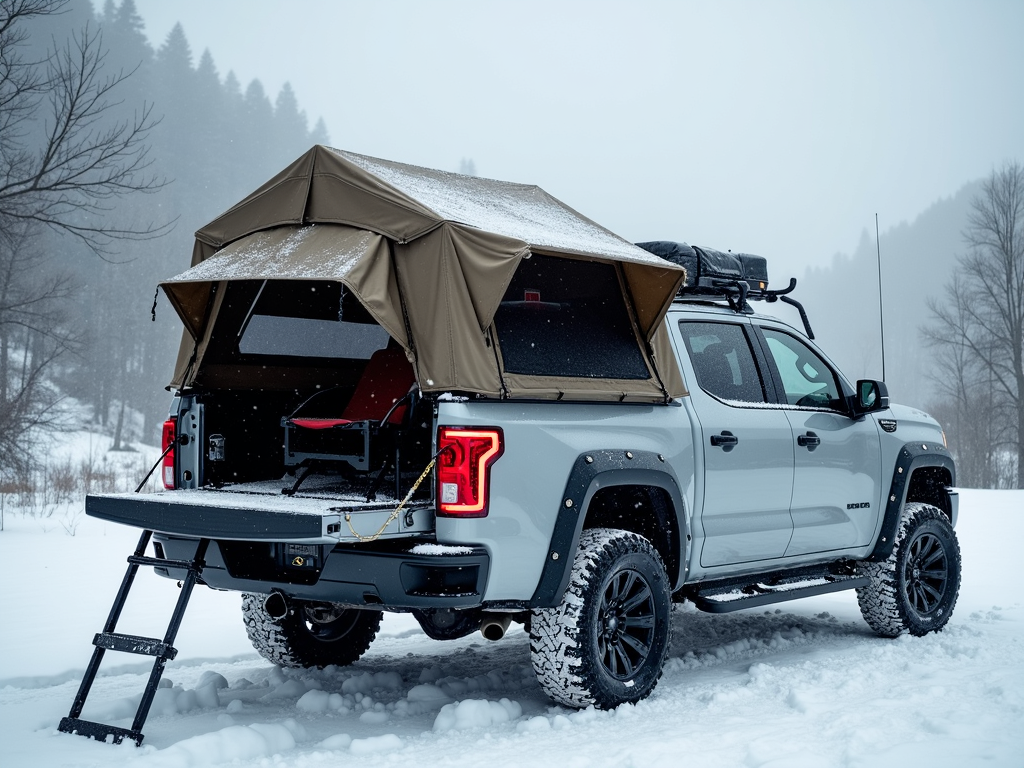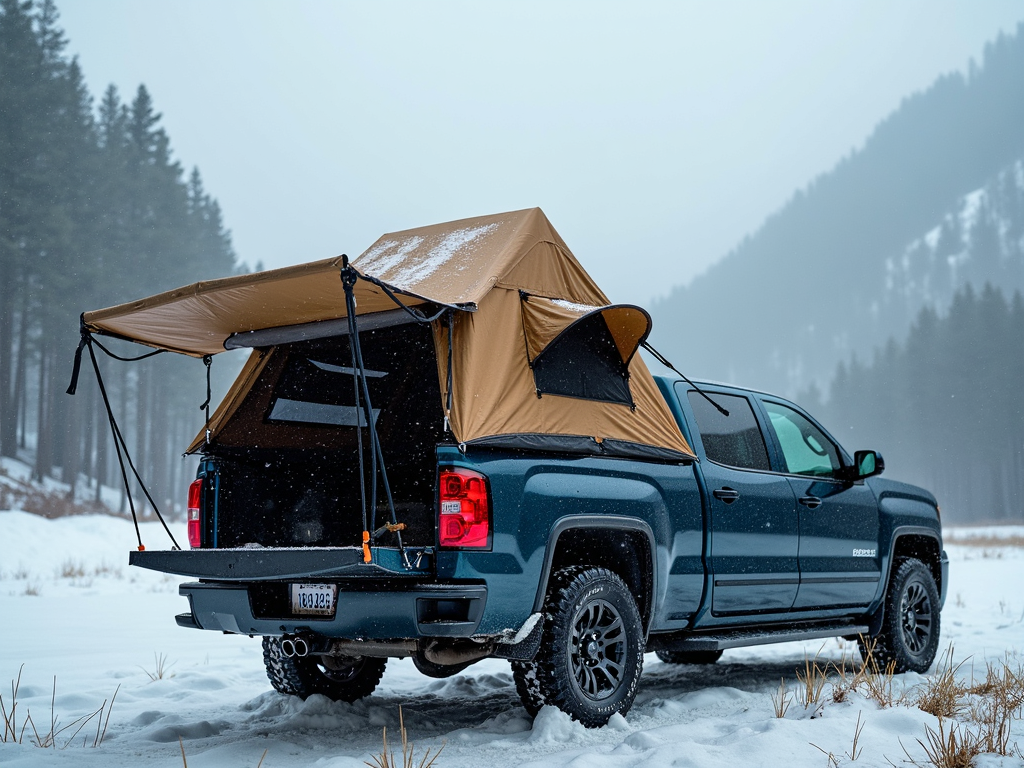Last October, I woke up floating.
Not metaphorically—literally floating in three inches of water inside my supposedly ‘waterproof’ truck bed tent. The storm that rolled through Arizona’s BLM land wasn’t even that bad. Just steady rain for six hours.

But there I was. Sleeping bag soaked. Gear ruined. Faith in manufacturer claims completely shot.
That night changed everything about how I approach truck bed camping.
See, after 8,000 miles of overlanding across 14 states, testing seven different pickup truck tents from Napier to Kodiak Canvas, I’ve learned something the industry doesn’t want you to know: most ‘waterproof’ truck bed tents aren’t.
Not really.
They’re water-resistant at best. And that distinction matters when you’re 40 miles from the nearest town on National Forest Service land.
What I discovered through months of real-world testing—and conversations with vendors at Overland Expo—will completely change how you think about truck tent camping waterproofing.
The ‘Waterproof’ Lie: What Manufacturers Won’t Tell You
Here’s the dirty secret: when Napier or Rightline Gear slaps ‘waterproof’ on their packaging, they’re playing fast and loose with definitions.
I pulled spec sheets from six major brands last month. You know what I found?
Most truck camping tents use materials rated at 1500-2000mm hydrostatic head. Sounds impressive, right?
Wrong.
A 1500mm rating means the fabric can withstand water pressure equivalent to someone sitting on wet fabric. That’s it. Real waterproofing—the kind that keeps you dry in Pacific Northwest downpours—starts at 3000mm minimum.
The outdoor industry knows this. Tent manufacturers for backpacking figured it out decades ago. But somehow, truck tent companies think we’re idiots who won’t notice.
The Coating Scam
They coat their polyester with a thin layer of polyurethane and call it waterproof truck tent material. After six months of UV exposure? That coating starts breaking down. After a year? You might as well sleep under a screen door.
I tested this myself with a Rightline Gear tent I’d used for 18 months on my Toyota Tacoma. Sprayed it with a garden hose at normal pressure. Water beaded for about 30 seconds, then started seeping through.
The real kicker? Even premium brands pull this nonsense. That $800 tent from REI? Same 1500mm rating as the $200 Amazon special. The only difference is marketing budget.
Overland Vehicle Systems gets closer with their full size truck tent—they use 600-denier ripstop rated at 2500mm. Still not true waterproofing, but at least they’re honest about calling it ‘weather-resistant’ in the fine print.
But material ratings are just the beginning. The real problems start where fabric meets fabric.

Why Your Pickup Bed Tent Leaks: The 7 Failure Points Nobody Discusses
After my Arizona swimming lesson, I became obsessed with finding every possible leak point in truck bed camping setups. Spent three months documenting failures across different models—from compact truck bed tents to massive Ford F-150 setups.
Here’s what nobody tells you about where water actually gets in.
First, the stake-out points. Every time you drive a stake through fabric, you create a potential leak. Most manufacturers use basic grommets. Water follows the stake right through. I’ve seen puddles form at every corner stake point after just two hours of rain.
Second, zippers. Oh man, the zippers. Even YKK zippers—supposedly the best—aren’t waterproof unless they’re welded or use storm flaps. Count how many truck tents have proper storm flaps. I’ll wait.
Third, the tailgate gap. This one’s brutal. Your truck bed has drain holes for a reason. When it rains, water pools. That pooled water finds the gap between your tent floor and the tailgate. Whether you’re running a Chevrolet Silverado or RAM 1500, the problem’s the same. Kodiak Canvas actually addresses this with their precision-fit design, but they’re the exception.
Fourth, bed rail contact points. Anywhere your tent touches metal, water wicks through. The pressure from tent fabric against wet bed rails creates a perfect pathway for moisture. Doesn’t matter if you’ve got a truck bed tent with awning—the rails still leak.
Fifth, condensation. Yeah, not technically a leak, but try explaining that when you wake up soaked. The Overland Vehicle Systems model includes an anti-condensation base. Know how many others do? Zero.
Sixth, seam construction. Heat-welded seams don’t leak. Sewn seams do. Period. Every needle hole is a potential failure point. Most pickup truck tents use sewn seams with basic seam tape that degrades after a few months.
Seventh, wind-driven rain. Your tent might handle vertical rainfall fine. But horizontal rain hitting at 40mph? Different story. The angle of attack changes everything. I watched water blow straight through door seams during a Wyoming windstorm.
So how do overlanding pros stay dry when the rest of us wake up in puddles?
Field-Tested Solutions: How Overlanding Pros Stay Dry in Any Weather
Last year at Overland Expo, I cornered three vendors who’ve been truck tent camping for decades. Their setups? Completely different from what manufacturers recommend.
These guys don’t trust factory waterproofing. They create their own.
Material Selection Matters
Start with materials. The pros gravitate toward 600-denier ripstop or heavier. Not because it’s inherently more waterproof, but because it holds aftermarket treatments better.
They’re using Gear Aid Seam Grip on every single seam, even factory-sealed ones. Annual ritual. Some go further—they remove factory seam tape entirely and apply fresh marine-grade tape.
One guy running a mid size truck tent on his Tacoma showed me his technique. Takes him three hours every spring. His ten-year-old Napier tent? Drier than my one-year-old “premium” model.
Strategic Setup
Site selection matters more than gear. On BLM camping sites, they scout for natural drainage. Never set up in a depression. Always park with the truck nose slightly upward so water runs away from the tent.
One vendor showed me his modular truck tailgate tent system. Not the flimsy add-ons manufacturers sell. Custom fabricated aluminum frame with heavy-duty tarp material. Creates a rain barrier that extends six feet beyond the tent. Water never touches the tent walls.
Pre-Trip Prep
They also prep differently. Before any trip, they spray every zipper with silicone lubricant that includes water repellent. They line their truck beds with specialized mats that channel water to the drain holes. They use painter’s tape to seal the gap between tent floor and tailgate.
Maintenance Schedule
Maintenance schedule? Religious. UV protectant every three months. Complete seam resealing annually. Zipper cleaning after every dusty trip. They treat their tents like technical equipment, not recreational truck camping gear.
The result? I watched one 4 season truck tent handle eight straight hours of Columbia River Gorge rain. Not a drop inside. The owner had been using the same Napier tent for six years. It looked rough but performed flawlessly.
Making Your Truck Bed Shelter Actually Waterproof
Ready to transform your leaky tent into a weatherproof truck bed shelter? Here’s the exact system these pros use.
First, forget what the truck tent installation manual says about waterproofing. Start with a complete seam audit. Use a flashlight inside the tent at night—light leaks show water entry points.
Next, invest in proper seam sealer. Not the garbage Cabela’s sells at the checkout. Marine-grade or mountaineering-grade only. Apply it to every seam, even if the manufacturer claims they’re sealed.
For truck bed tent accessories, skip the branded nonsense. Get industrial-grade tarp clips and bungee cords. Create your own awning system that actually diverts water away from the tent body.
The tailgate gap fix? Cut a pool noodle lengthwise. Stuff it in the gap. Tape over with Gorilla tape. Ugly? Yeah. Effective? Absolutely.
The Bottom Line on Waterproof Truck Tents
That night in Arizona taught me something valuable: trusting manufacturer claims about waterproofing is like trusting gas station sushi. Sure, it might work out, but why risk it?
The truth is, every portable truck tent leaks eventually. Whether you’re running the best truck bed tents money can buy or a budget special, water finds a way. The question is whether you’ll be ready when it happens.
Armed with real knowledge about hydrostatic ratings, weak points, and proven weatherproofing techniques, you can turn even a budget tent into reliable shelter.
Start tonight—grab a flashlight and inspect your tent seams. Find those potential leak points before they find you.
Because there’s nothing worse than learning about waterproofing failures at 2 AM in a thunderstorm, 40 miles from civilization. Trust me on that one.
The overlanding pros have this figured out. Now you do too.
Next time you see ‘waterproof’ on a truck tent box, you’ll know exactly what that means. And more importantly, what it doesn’t.
Your truck camping gear deserves better than manufacturer lies. Your sleep system definitely does. And after 8,000 miles of testing, I can tell you exactly how to get it.